
Another penalty has historically been audio quality. There’s no denying the fact that acoustics change when the roof is taken out of the equation, and it’s about time an automaker took notice.
For the 2016 MX-5, Mazda will introduce a new Bose stereo system specifically tailored for open-air driving.
The package has two modes: one for when the top is down and another for when it’s up.
When the sky is your passenger, Bose’s ‘AudioPilot’ noise compensation technology monitors wind and road noise and adjusts EQ settings automatically to improve clarity. But it doesn’t stop there.
Even the speaker layout is designed to enhance the convertible’s aural experience. Headrest speakers are back for the 2016 model year — 2-inch Bose ‘UltraNearfield’ units to be exact — and they were engineered specifically to deliver sound directly to the driver’s (and passenger’s) ears.
There’s also a 6.5-inch speaker in each door, 1-inch ‘neodymium’ tweeters on each A-pillar, and a 5.25-inch woofer behind the passenger footwell bestowing low-end punch. Mazda says the frontal placement of the sub was important to preserve cabin and trunk space.
Providing power for the system is a 7-channel digital amplifier, which is mounted below the MX-5’s convertible top storage area.
While a solution to the insect issue may require some further advances in tech, when it comes to sound quality, Mazda’s tailored design has removed a lot of the pitfalls when putting the roof down.
Editors' Recommendations
- PS5’s first major system update adds USB hard drive support, new social features
- Fault with Mazda3’s emergency braking system could cause random activation
- Subaru and Mazda join Toyota’s self-driving car development venture




